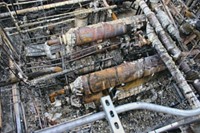Advertisement
Grab your lab coat. Let's get started
Welcome!
Welcome!
Create an account below to get 6 C&EN articles per month, receive newsletters and more - all free.
It seems this is your first time logging in online. Please enter the following information to continue.
As an ACS member you automatically get access to this site. All we need is few more details to create your reading experience.
Not you? Sign in with a different account.
Not you? Sign in with a different account.
ERROR 1
ERROR 1
ERROR 2
ERROR 2
ERROR 2
ERROR 2
ERROR 2
Password and Confirm password must match.
If you have an ACS member number, please enter it here so we can link this account to your membership. (optional)
ERROR 2
ACS values your privacy. By submitting your information, you are gaining access to C&EN and subscribing to our weekly newsletter. We use the information you provide to make your reading experience better, and we will never sell your data to third party members.
Safety
Florida Explosion Investigation Yields Preliminary Results
Chemical safety board says uncontrolled reactor vessel temperature, pressure led to four deaths
by Jeff Johnson
January 7, 2008

Excess reactor pressure and temperature led to a runaway chemical reaction and a fire and explosion that killed four workers and injured a dozen people at a Jacksonville, Fla., chemical company a few days before Christmas.
These are the preliminary findings of an investigation of the Dec. 19 T2 Laboratories accident. The investigation was conducted by the Chemical Safety & Hazard Investigation Board (CSB).
"The blast was among the most powerful ever examined by the chemical safety board," says Robert Hall, who is leading the CSB investigation. To rupture the reactor vessel's 3-inch-thick steel walls required a pressure of several thousand pounds per square inch, he estimates.
Along with the immediate deaths and injuries, one worker remains hospitalized by the accident, which was described in press accounts as a sharp, explosive blast, like a gunshot, followed by black smoke and "a hellish inferno."
T2 is a small company with about a dozen employees at one production site. Plant workers were manufacturing methylcyclopentadienyl manganese tricarbonyl, an additive used to boost gasoline octane rating. They were using a high-pressure reactor vessel that ruptured as the mix of organic materials reacted with metallic sodium, according to the board's preliminary report released on Jan. 3. As the reactor's flammable contents exited the vessel and mixed with oxygen, they ignited, releasing large amounts of heat, Hall says.
Injuries occurred 750 feet from the reactor's location, and debris has been found a mile from the blast. Parts of the steel reactor vessel, weighing several hundred pounds, were discovered 750 feet from the plant.
Hall notes that accidents resulting from uncontrolled reactions like this one have been identified by the board previously as particularly deadly and important to eliminate. Some 167 serious reactive chemical accidents have occurred in the U.S. over a 20-year period, according to a CSB study. These accidents have killed 108 workers.
Hall predicts the CSB investigation will take many months to complete, and he notes that investigators have not yet gained full access to the site due to the many hazardous chemicals that remain there.
The CSB team will conduct reactive chemistry testing using the company's "recipe" to better understand what actually occurred inside the reactor, Hall says. The study will also examine the company's specific safety standards and state and federal regulations to see how they can be improved to reduce the likelihood of such accidents.
CSB conducts root-cause chemical accident investigations and has eight in process now. It has completed some 43 investigations during its 10-year history.






Join the conversation
Contact the reporter
Submit a Letter to the Editor for publication
Engage with us on Twitter